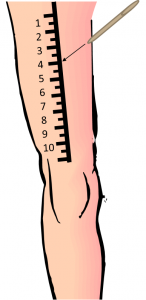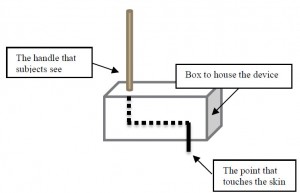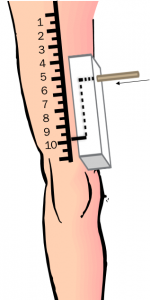Experimental Methods:
Using a tactile-visual discrepancy test on subjects, participants will be biased into associating a new sensation of touch to various locations on their upper leg.
Initial Assessment: Each subject will have a 10-inch ruler drawn along the length of their upper leg, measured in ¼ inch increments. The researcher will select ten consecutive points to touch, each one being touched a total of ten times, in random order. The subject will be blindfolded during each touch, but will uncover their eyes to determine where they think they were touched.

Phases 1 and 3
Intervention: By touching test subjects in one location while simultaneously creating an illusion that makes the touch appear to be occurring one inch proximally, the individuals will adapt their self-awareness to the new tactile sensations (see Figure 1). In the figure, a box contains the tactile wand, which has one end protruding from the box for the subjects to see, and a tip that is offset within the container. This will lead them to associate feelings of touch in one location as coming from a different location.
Subjects will be touched for 1 minute with the intervention device.
Post Intervention Assessment: The assessment described above will be performed again, however the chosen points will be offset distally by one inch, to quantify the effect of the intervention.
Downloadable files:
YIS Abstract Maddie Graham Final 2014


